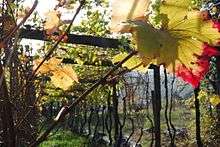Baratuciat

Baratuciat is a white Italian wine grape variety that is grown in the Piedmont wine region of northwest Italy. For most of its history, Baratuciat was used mainly as a table grape with some limited use for wine production with sweet late-harvest dessert wines.[1] On June 23, 2008, the grape was officially added to the Italian registry of wine grape varieties.[2]
In the Piedmontese language, the name Baratuciat is similar to the term used in the local dialect to denote cat's testicles, which ampelographers theorize may be a reference to the morphological shape of the grape's berries[3] or to the characteristic "Sauvignon blanc-like" aromas of the grape, and wine made from it, which can be similar to a cat's litter box and elderflowers.[1]
Today, Baratuciat is found almost exclusively in the province of Turin, particularly in the Susa Valley, where it is found in the villages of Almese, Buttigliera Alta, Rosta, Rubiana and Villar Dora.[1]
History

Unlike many Piemontese varieties, Baratuciat does not have a long history of wine production use in Piedmont with only written records in the twentieth and twenty-first century describing its use for both table grape and winemaking. Ampelographers believe that the name Baratuciat is derived from the term used in the local Piemontese dialect for the testicles of cats.[1]
Viticulture
Baratuciat is a mid-ripening grape variety that can be very vigorous and prone to producing a large canopy and high yields if not kept in check by winter pruning, green harvesting and canopy management techniques throughout the growing season. The grape tends to be a high acid variety that lends itself well to balancing the sugars in the production of sweet, late-harvest dessert wines.[1]
Baratuciat berries tend to be small with very thick skins that are prone to infection by botrytis bunch rot. While for some grape varieties, such as Sauvignon blanc, Furmint and Sémillon, growing in some wine regions, such as Sauternes in Bordeaux and the Tokaj wine region of Hungary, the development of "noble rot" can be desirable[4] in the production of dessert wines. But in the case of Baratuciat, the presence of Botrytis cinerea is usually considered a viticultural hazard.[1]
Wine regions

Baratuciat was only added to the official registry of Italian grape varieties in 2008 which means that plantings of the variety were not counted during the 2000 census. However, ampelographers believe that the grape is almost exclusively grown in the Susa Valley located within the province of Turin. The villages of Almese, Buttigliera Alta, Rosta, Rubiana and Villar Dora have the most significant plantings of Baratuciat with one winery in Almese cultivating the grape on a commercial scale since the early 21st century.[1] Wine critics are watching the development of plantings of the variety within the (currently) red wine only Denominazione di origine controllata (DOC) of Valsusa, noting that the grape has "potential" in this region.[5]
A 2011 study by the University of Adelaide in Australia, documented 2 hectares (4.9 acres) of the grape variety being cultivated in 2010 which ranked it as the 1124th most cultivated wine grape variety in the world.[6]
Styles
According to Master of Wine Jancis Robinson, Baratuciat tends to produce very "Sauvignon blanc-like" wines with high levels of acidity and characteristic elder flower and "cat box" aromas. Like many white Italian wine varieties, the grape can also have some slight bitter notes on the finish. Throughout most of its history, the grape was mainly used as an eating variety on the table with some limited use for late harvest wines.[1]
Synonyms
Over the years, Baratuciat has also been known by or with the synonyms of Bertauciat[7] and Bertacuciàt.[1]
References
- 1 2 3 4 5 6 7 8 9 J. Robinson, J. Harding and J. Vouillamoz Wine Grapes - A complete guide to 1,368 vine varieties, including their origins and flavours pgs 82-83, 374 & 954-955 Allen Lane 2012 ISBN 978-1-846-14446-2
- ↑ Registro Nazionale della Varietà di vite "Baratuciat", Accessed: March 30th, 2014
- ↑ Wein-Plus "Baratuciat" Glossary. Accessed: March 30th, 2014
- ↑ J. Robinson (ed) “The Oxford Companion to Wine” Third Edition pg 485 Oxford University Press 2006 ISBN 0-19-860990-6
- ↑ Riccardo Modesti "Valsusa DOC, tra biodiversità e piccoli numeri Archived November 16, 2006, at the Wayback Machine." Wine Report (Italian), March 6th, 2003. Accessed: March 30th, 2014
- ↑ Kym Anderson and Nanda R. Aryal "Which Winegrape Varieties are Grown where? A Global Empirical Picture" pg 40, University of Adelaide Press 2011. Accessed: March 30th, 2014
- ↑ Vitis International Variety Catalogue (VIVC) Baratuciat Accessed: March 30th, 2014